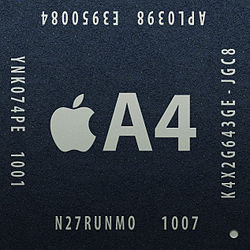 | |
 iPhone 4 (GSM model) in black | |
| Developer | Apple |
|---|---|
| Manufacturers | Foxconn (UMTS/GSM model) Pegatron (CDMA model) [1] |
| Type | Smartphone |
| Generation | 4th |
| First released | GSM model (black): June 24, 2010 [a] CDMA model (black): February 10, 2011 [a] GSM and CDMA models (white): April 28, 2011 [a] 8 GB models: October 4, 2011 [a] |
| Discontinued | September 10, 2013 |
| Predecessor | iPhone 3GS |
| Successor | iPhone 4S |
| Related | iPod Touch (4th generation) |
| Form factor | Slate |
| Dimensions | 115.2 mm (4.54 in) H 58.6 mm (2.31 in) W 9.3 mm (0.37 in) D |
| Weight | 137 g (4.8 oz) |
| Operating system | Original: iOS 4.0 (GSM model), iOS 5.0 (8 GB model), iOS 4.2.10 (CDMA model) Last: iOS 7.1.2, released June 30, 2014 |
| System-on-chip | Apple A4 [2] |
| CPU | 1 GHz (Underclocked to 800 MHz) single core 32-bit ARM Cortex-A8 |
| GPU | PowerVR SGX535 [2] |
| Memory | 512 MB LPDDR DRAM [3] |
| Storage | 8, 16, or 32 GB flash memory |
| Battery | 3.7 V, 5.3 W⋅h (1420 mA⋅h) Lithium-ion battery [4] |
| Rear camera | 5 MP back-side illuminated sensor HD video (720p) at 30 frame/s 1.75 μm size pixels 5× digital zoom 4 element lens LED flash Photo and video geotagging |
| Front camera | 0.3 MP VGA (480p) at 30 fps Tap to focus video or still images Photo and video geotagging |
| Display | 3.5 in (89 mm) diagonal 3:2 aspect ratio widescreen LED backlit IPS TFT LCD 960×640 resolution at 326 ppi (0.61 megapixels) 800:1 contrast ratio (typical) 500 cd/m2 max brightness (typical) Fingerprint-resistant oleophobic coating on front and back glass |
| Sound | Single loudspeaker 3.5 mm TRRS, frequency response: 20 Hz to 20 kHz |
| Connectivity | Wi-Fi (802.11 b/g/n) (2.4 GHz only) Bluetooth 2.1 + EDR GSM model: quad-band GSM/GPRS/EDGE (800, 850, 900, 1800, 1900 MHz) Quad-band UMTS/HSDPA/HSUPA (800, 850, 900, 1900, 2100 MHz) (800 MHz is not yet officially supported by Apple) CDMA model: dual-band CDMA/EV-DO Rev. A (800, 1900 MHz) |
| Data inputs | Multi-touch touchscreen display Dual microphone 3-axis gyroscope 3-axis accelerometer Digital compass Proximity sensor Ambient light sensor |
| Model | A1332 (GSM model or 8 GB model) A1349 (CDMA model) [5] |
| Website | Apple – iPhone 4 – Video calls, multitasking, HD Video, and more at the Wayback Machine (archived October 14, 2010) |
| This article is part of a series on the |
| iPhone |
|---|
The iPhone 4 is a smartphone that was developed and marketed by Apple. It is the fourth generation of the iPhone lineup, succeeding the iPhone 3GS and preceding the iPhone 4s. Following a number of notable leaks, the iPhone 4 was first unveiled on June 7, 2010, at Apple's Worldwide Developers Conference in San Francisco, [6] and was released on June 24, 2010, in the United States, United Kingdom, France, Germany, and Japan.
Contents
- History
- Prototypes
- Release
- Discontinuation
- Hardware
- Display
- Camera
- Connectivity
- Gyroscope and accelerometer
- Processor, memory and storage
- Micro-SIM
- Design
- Software
- Accessories
- Bumper
- Reception
- Pre-release
- Reviews
- Technical problems
- iPhones in space
- See also
- Notes
- Notable movies shot with iPhone 4
- References
- External links
The iPhone 4 introduced a new hardware design to the iPhone family, which Apple's CEO Steve Jobs touted as the thinnest smartphone in the world at the time; it consisted of a stainless steel frame that doubled as an antenna, with internal components situated between two panels of aluminosilicate glass. [7] The iPhone 4 introduced Apple's new high-resolution "Retina display" (with a pixel density of 326 pixels per inch) while maintaining the same physical size and aspect ratio as its predecessors, Apple's A4 system-on-chip, and with iOS 4—which notably introduced multitasking functionality and app folders. It was the first iPhone at the time to include a front-facing camera, which made possible Apple's new FaceTime video chat service, and the first to be released in a version for CDMA networks, ending AT&T's period as the exclusive carrier of iPhone products in the United States.
The iPhone 4 received a largely positive reception, with critics praising its revamped design and more powerful hardware, in comparison to previous models. While it was a market success (with over 600,000 pre-orders within 24 hours), the release of the iPhone 4 was plagued by highly publicized reports concerning abnormalities in its new antenna design that caused the device to lose its cellular signal if held in a certain way. Most direct contact with the phone's outer edge would cause a significant decrease in signal strength. Apple released iOS 4.0.1 to try to fix these issues, but were unsuccessful. [8]
The iPhone 4 spent the longest time as Apple's flagship iPhone model at fifteen months. Although the succeeding 4S was announced in October 2011, the 4 continued to be sold as a midrange model until September 2012, and thereafter as the entry-level offering in Apple's lineup until September 2013 with the announcement of the iPhone 5s and iPhone 5c. The iPhone 4 had one of the longest lifespans of any iPhone ever produced, spanning close to four years and available in some developing countries until early 2015.








